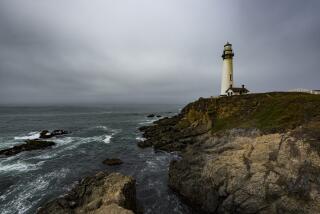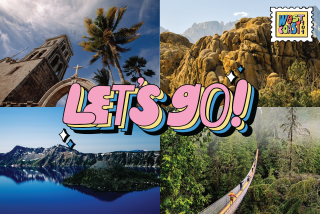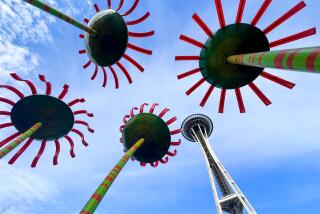WHAT’S YOUR GQ*?
- Share via
We are, geographically speaking, not worthy. Sure, millions of Americans these days can reflexively recite the ZIP code of Beverly Hills. But when it comes to more relevant geographic knowledge, too many of us seem to be snoozing near the rear of the global class.
The questions on these pages will give brave readers a chance to assess their own world-awareness. But before you start squinting at the horizons and wondering what separates an isthmus from an archipelago (salt water, generally), consider the lay of the educational land.
In 1988 and 1989, Gallup surveyors handed out blank world maps to more than 12,000 citizens of 10 nations and asked them to locate various countries and global features. As it turns out, one in four Americans couldn’t find the Pacific Ocean, and among respondents 18 to 24 years old the U.S. ranked dead last in geographical awareness. More tests followed, but that was enough for the people at the National Geographic Society. They launched a nationwide geography education campaign, the most visible element of which is the annual National Geography Bee.
The 1993 bee began with schoolroom competitions in January, and advanced to statewide contests in April. This year’s contest, which officials say drew participation of nearly 6 million public and private school students in grades 4 through 8, climaxes with national finals this Tuesday and Wednesday. (In Los Angeles, the final rounds are scheduled for broadcast on KCET Channel 28 Wednesday at 8 p.m.; in Orange County, on KOCE Channel 50 Friday, June 11, at 4 p.m.) Student finalists from 50 states, five U.S. territories, the District of Columbia and the Department of Defense’s schools will be questioned by moderator Alex Trebek of TV’s “Jeopardy!” fame.
Inevitably, the competition will come down to a single question, such as the one Trebek hurled last year at eighth-grader Lawson Fite of Vancouver, Wash.: “Many coastal countries have established so-called EEZs, areas extending 200 nautical miles from shore over which countries have sovereign rights for resource exploration. What do the initials EEZ stand for?”
“Exclusive economic zone,” said Lawson, thereby winning a $25,000 college scholarship from co-sponsors Amtrak and National Geographic World, the National Geographic Society’s magazine for children. This year’s top prize is the same. Meanwhile, those of us puzzling over the questions herein--which were adapted from those posed in earlier rounds of this year’s bee--have only our pride at stake. And if things don’t go well, the people at National Geographic and Alex Trebek and the rest don’t ever have to know. We can always set the paper aside, drive out to the beach, and clear our minds with a stroll there on the sandy shores of . . . you know, that big body of water.
* Geography Quotient
MULTIPLE CHOICE
1. The famous herders of Tanzania are known by what name?
A. Berbers
B. Ibo
C. Masai
D. Swahili
2. The kayak was first used for hunting and fishing by ancestors of people who live in lands bordering which of the Earth’s four oceans?
A. Atlantic
B. Pacific
C. Indian
D. Arctic
3. The cathedral above is a landmark in the Italian city considered to be the birthplace of the Renaissance. Name this city.
A. Venice
B. Florence
C. Naples
D. Pisa
4. The time in most of Mexico is the same as that in which standard U.S. time zone?
A. Eastern
B. Mountain
C. Central
D. Pacific
5. Which European city does not have an abundance of canals?
A. Copenhagen
B. St. Petersburg
C. Barcelona
D. Venice
6. Tanzania is one of the chief sources for a dense, dark wood that is used to make clarinets and certain piano keys. Name this wood, which is one of the world’s most expensive timber products.
A. mahogany
B. ironwood
C. purpleheart
D. ebony
7. The prime meridian is which line of longitude?
A. 60 degrees
B. 90 degrees
C. 0 degrees
D. 180 degrees
8. Mt. Whitney, highest mountain in the lower 48 states, is in which state?
A. California
B. Washington
C. Idaho
D. Colorado
9. Most Japanese car manufacturing plants in the United States are concentrated in six central states. Which of the following states is not one of the six?
A. Tennessee
B. Kentucky
C. Michigan
D. Arkansas
10. The Equator crosses which of these African countries?
A. South Africa
B. Zaire
C. Egypt
D. Nigeria
11. The place where the boundaries of Arizona, Colorado, New Mexico and Utah meet is known by which name?
A. Grand Fork
B. Hole-in-the-Wall
C. Window Rock
D. Four Corners
12. Which of the following is not a sea in Antarctica?
A. White
B. Weddell
C. Ross
D. Bellingshausen
13. What is the term for the two days during the year when the Earth’s axis is tilted at its greatest angle toward or away from the sun?
A. equinox
B. solstice
C. syzygy
D. gravity
14. Amelia Earhart flew from Newfoundland to this westernmost island in the British Isles on her historic solo flight across the Atlantic.
A. Isle of Man
B. Island of Skye
C. Island of Arran
D. Ireland
15. Some of the oldest wooden tools, including boomerangs, barbed spears and throwing sticks, have been recovered from Wyrie Swamp. Name the native people who crafted these tools.
A. Aborigines
B. Pygmies
C. Maori
D. Hottentots
MIX AND MATCH
In the past half-century, as former colonial empires have dissipated, countries throughout Asia, Africa, South America and the Pacific have changed their names to reflect their independence. Match the current name of the country with its prior name.
Name . . . . . . . . . . . Colonial Name
1. Zambia . . . . . . . . . . . . A. Basutoland
2. Tuvalu . . . . . . . . . . . . B. Upper Volta
3. Bangladesh . . . . . . . . . . C. Ubangi-Shari
4. Lesotho . . . . . . . . . . . . D. Dutch Guiana
5. Djibouti . . . . . . . . . . . E. British Guiana
6. Suriname . . . . . . . . . . . F. Portuguese Guinea
7. Burkina Faso . . . . . . . . . G. French Somaliland
8. Guinea-Bissau . . . . . . . . . H. New Hebrides
9. Vanuatu . . . . . . . . . . . . I. Northern Rhodesia
10. Botswana . . . . . . . . . . . J. East Pakistan
11. Guyana . . . . . . . . . . . . K. Ellice Islands
12. Central African Republic . . . L. Bechuanaland
TRUE or FALSE?
1. The Atlantic island that derives its conventional name from the one given to it by the Viking Erik the Red is Iceland.
2. The anaconda, a type of constrictor snake, is native to the equatorial region of only one continent, Africa.
3. When the Chinese took control of Tibet, Tibet’s spiritual leader fled and set up a government-in-exile in the neighboring country of Nepal.
4. A U.S. territory where men outnumbered women 6 to 1 was, nonetheless, the first to grant women the right to vote. This progressive legislation was passed by the present-day state of Wyoming.
5. The U.S. government recently has advised against travel by U.S. citizens to Peru because of increased violence by a terrorist group known as the Shining Path.
6. The theory that the Earth’s crust is made up of many large pieces that slowly move is called plate tectonics.
7. Skyscrapers, structures that have changed urban skylines around the world, had their beginnings in the U.S. in Boston.
8. Angel Falls, the world’s highest waterfall, is in South America.
9. St. Petersburg is the home of the Bolshoi Theater, where the world-famous ballet company performs.
10. Native Americans make up the largest ethnic group in two South American countries, Bolivia and Peru.
11. Most of the Earth’s available fresh water is stored in underground formations called cisterns.
12. China is second only to the United States in the production of corn.
13. Many bridges of braided grass that span gorges in the Peruvian Andes were originally constructed by the pre-Columbian Toltecs.
14. The African mountain system that blocks moisture-carrying winds from the Mediterranean from reaching parts of the Sahara is the Atlas.
15. Finland and Czechoslovakia were formed as a result of treaties associated with World War II.
16. The above tent-like dwelling, used in Central Asia, is known as a yurt.
17. The Tasman Sea separates most of northeastern Africa from Asia.
18. The small European country bordered by Belgium, France and Germany is Liechtenstein.
19. The river that borders or moves through five of the six countries that make up the mainland of Southeast Asia is the Mekong.
DO YOU KNOW?
1. Which state is part of the region commonly called Tornado Alley--Nevada or Oklahoma?
2. The use of what kind of energy helps make Reykjavik, Iceland, one of the world’s cleanest cities?
3. Which city, strategically located on the Bosporus Strait, has been an international center for trade and commerce for centuries?
4. Saguaro, prickly pear and cholla are varieties of a kind of plant most commonly associated with what kind of climate?
5. The echidna, or spiny anteater, is native to Australia and the large island directly north of that country. Name this large island.
6. The world’s deepest lake holds more fresh water than is in all of North America’s Great Lakes combined. Name this Russian lake.
7. A chador, a tentlike garment that keeps much of a woman’s face and body hidden from public view, is most commonly associated with women who are followers of what religion?
8. The Tongass National Forest, largest in the United States, covers most of the southeastern, or panhandle, region of which Pacific state?
9. The music of steel bands, which is played on specially tuned empty oil drums, is most commonly associated with which island region?
10. India and a neighboring island country, pictured below, together produce almost half of the world’s tea. Name the other country.
11. Through which strait in the Middle East do tankers carry millions of barrels of oil each day?
12. What is the name of the aboriginal people who live on the island of Hokkaido?
13. What is the term for the weather boundary that forms when two air masses of different temperature and humidity come together?
14. Brussels, a city that straddles a cultural boundary between the Flemings in northern Belgium and the Walloons in the south, has two official languages. Name one of these languages.
15. Feluccas, sailing vessels like the one shown at right, have been in use since ancient times. They are commonly associated with the eastern Mediterranean Sea and which river in Africa?
16. Egypt, Ethiopia and Zaire all border Africa’s largest country in terms of land area. Name this country.
17. The location of a city on the Nile River just south of the delta has helped it develop into the cultural capital of the Arab world. Name this city.
18. In which mountainous country in the southwestern Pacific does the total number of sheep and cattle outnumber people by more than 10 to 1?
19. Torii gates, which mark the entrances to Shinto shrines, are commonly found in which country?
20. The world’s longest artificial sea barrier was built to keep North Sea storm surges from flooding the southwestern delta region of a European country. Name this European country.
21. A region known as the Sand Hills, which includes the largest area of dunes in the Western Hemisphere, extends from southern South Dakota to the North Platte River, and covers much of which state?
22. Which continent has the larger land area--Europe or North America?
23. If you wanted to live in a region that is warm throughout the year, would you be likely to choose a location at a high latitude or a low latitude?
24. Which peninsula separates the Atlantic Ocean from the Gulf of Mexico--Florida or Yucatan?
25. Most of the more than 1 million Muslims who live in France have emigrated from countries in the northern part of which continent?
26. The highest continental mountain ranges in the Western Hemisphere are closest to which one of the Earth’s four oceans?
27. Name the mineral-rich region in Russia that stretches roughly from the Urals to the Pacific Ocean, covering an area larger than Canada.
28. In many countries, farmers produce food primarily to feed their families rather than to sell at market. What is this type of farming called?
29. The two largest islands in the Mediterranean Sea are governed by which country?
30. The Maastricht Treaty, if approved, would provide a plan for the political and economic union of which continent?
31. The southernmost major island in the Caribbean is the site of the region’s largest celebration of Carnival, a festival similar to Mardi Gras in the United States. Name this island.
32. Followers of a religion that rejects certain Hindu and Islamic beliefs live primarily in India’s Punjab region. What are these people called?
33. In what mountain system do farm children help grow potatoes and herd the animals--alpacas--shown above?
34. Name the mountain pass between the present-day countries of Afghanistan and Pakistan that has served as a corridor for trade and conquering armies throughout history.
35. Volcanic, fold, fault-block and dome are terms that describe the chief building processes of what kind of landform?
36. Calm regions known as the horse latitudes are centered on two named lines of latitude. What is the name of one of these lines of latitude?
37. The Guianas, a region along the northern coast of South America, was colonized by Great Britain and two other European powers. Name these other two European powers.
38. Name the only continent through which the International Date Line passes.
ANSWERS
MULTIPLE CHOICE
1. C. Masai, 2. D. Arctic, 3. B. Florence,
4. C. Central, 5. C. Barcelona, 6. D. ebony,
7. C. 0 degrees, 8. A. California,
9. D. Arkansas, 10. B. Zaire, 11. D. Four Corners,
12. A. White, 13. B. solstice, 14. D. Ireland,
15. A. Aborigines
TRUE OR FALSE
1. F (it’s Greenland), 2. F (it’s South America), 3. F (India),
4. T, 5. T, 6. T, 7. F (Chicago), 8. T, 9. F (Moscow),
10. T, 11. F (aquifers), 12. T, 13. F (Incas), 14. T,
15. F (World War I), 16. T, 17. F (it’s the Red Sea;
the Tasman Sea separates Australia and New Zealand),
18. F (it’s Luxembourg), 19. T
DO YOU KNOW?
1. Oklahoma, 2. geothermal energy, 3. Istanbul, 4. arid, desert, dry, 5. New Guinea, 6. Lake Baikal, 7. Islam, 8. Alaska, 9. West Indies or Lesser Antilles, 10. Sri Lanka, 11. Strait of Hormuz, 12. Ainu, 13. front, 14. Dutch, French, 15. Nile, 16. Sudan, 17. Cairo, 18. New Zealand, 19. Japan, 20. Netherlands, 21. Nebraska, 22. North America, 23. low latitude, 24. Florida, 25. Africa, 26. Pacific, 27. Siberia, 28. subsistence farming, 29. Italy, 30. Europe, 31. Trinidad, 32. Sikhs, 33. Andes, 34. Khyber Pass, 35. mountains, 36. Tropic of Cancer, Tropic of Capricorn, 37. France and the Netherlands, 38. Antarctica
MIX AND MATCH
1-I, 2-K,
3-J, 4-A,
5-G, 6-D,
7-B, 8-F,
9-H, 10-L,
11-E, 12-C
More to Read
Sign up for The Wild
We’ll help you find the best places to hike, bike and run, as well as the perfect silent spots for meditation and yoga.
You may occasionally receive promotional content from the Los Angeles Times.







